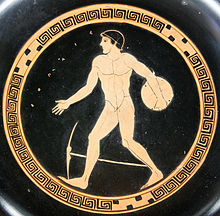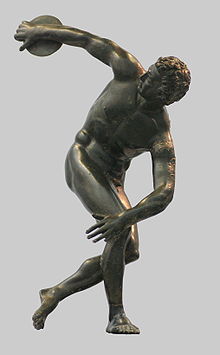- Discobolus
-
 The Townley Discobolus at the British Museum, with incorrectly restored head.
The Townley Discobolus at the British Museum, with incorrectly restored head.
The Discobolus of Myron ("discus thrower" Greek Δισκοβόλος, "Diskobolos") is a famous Greek sculpture that was completed towards the end of the Severe period, circa 460-450 BC. The original Greek bronze is lost. It is known through numerous Roman copies, both full-scale ones in marble, such as the first to be recovered, the Palombara Discopolus, or smaller scaled versions in bronze. A discus thrower is depicted about to release his throw: "by sheer intelligence", Sir Kenneth Clark observed in The Nude (1956:p 239f) "Myron has created the enduring pattern of athletic energy. He has feasible, and he has given it the completeness of a cameo." The moment thus captured in the statue is an example of rhythmos, harmony and balance. Myron is often credited with being the first sculptor to master this style. Naturally, as always in Greek athletics, the Discobolus is completely nude. His pose is said to be unnatural to a human, and today considered a rather inefficient way to throw the discus.[1] Also there is very little emotion shown in the discus thrower's face, and "to a modern eye, it may seem that Myron's desire for perfection has made him suppress too rigorously the sense of strain in the individual muscles," Clark observes. The other trademark of Myron embodied in this sculpture is how well the body is proportioned, the symmetria.
The potential energy expressed in this sculpture's tightly-wound pose, expressing the moment of stasis just before the release, is an example of the advancement of Classical sculpture from Archaic. The torso shows no muscular strain, however, even though the limbs are outflung.
Contents
Reputation in Antiquity
Myron's Discobolus was long known from descriptions, such as the dialogue in Lucian of Samosata's work Philopseudes:
- "When you came into the hall," he said, "didn't you notice a totally gorgeous statue up there, by Demetrios the portraitist?" "Surely you don't mean the discus-thrower," said I, "the one bent over into the throwing-position, with his head turned back to the hand that holds the discus, and the opposite knee slightly flexed, like one who will spring up again after the throw?"
- "Not that one," he said, "that's one of Myron's works, that Diskobolos you speak of..." (Lucian of Samosata, Philopseudes c. 18)[2]
 The discobolus motif on an Attic red-figured cup, ca. 490 BC, is static by comparison.
The discobolus motif on an Attic red-figured cup, ca. 490 BC, is static by comparison.
Discobolus and Discophorus
Prior to this statue's discovery the term Discobolus had been applied in the seventeenth and eighteenth centuries to a standing figure holding a discus, a Discophoros, which Ennio Quirino Visconti identified as the Discobolus of Naukydes of Argos, mentioned by Pliny (Haskell and Penny 1981:200).
Discobolus Palombara
The Discobolus Palombara, the first copy of this famous sculpture to have been discovered, was found in 1781. It is a first century AD copy of Myron's original bronze. Following its discovery at a Roman property of the Massimo family, the Villa Palombara on the Esquiline Hill, it was initially restored by Giuseppe Angelini; the Massimi installed it initially in their Palazzo Massimo alle Colonne and then at Palazzo Lancelotti. The Italian archaeologist Carlo Fea identified the sculpture as a copy from the original of Myron. It was instantly famous, though the Massimo jealously guarded access to it (Haskell and Penny 1981:200).
In 1937 Adolf Hitler negotiated to buy it, and eventually succeeded in 1938, when Galeazzo Ciano, Minister of Foreign Affairs, sold it to him for five million lire, over the protests of Giuseppe Bottai, Minister of Education, and the scholarly community. It was shipped by rail to Munich and displayed in the Glyptothek; it was returned in 1948. It is now in the National Museum of Rome, displayed at the Baths of Diocletian.
Townley Discobolus
After the discovery of the Discobolus Palombara a second notable Discobolus was excavated, at Hadrian's Villa in 1790, and was purchased by the English antiquary and art dealer established in Rome, Thomas Jenkins, at public auction in 1792. (Another example, also found at Tivoli at this date, was acquired by the Vatican Museums.) The English connoisseur Charles Townley paid Jenkins £400 for the statue, which arrived at the semi-public gallery Townley commissioned in Park Street, London, in 1794. The head was wrongly restored, as Richard Payne Knight soon pointed out, but Townley was convinced his was the original and better copy.
It was bought for the British Museum, with the rest of Townley's marbles, in July 1805 (illustration, left).[3]
Other copies
 Roman bronze reduction of Myron's Discobolus, 2nd century AD (Glyptothek, Munich).
Roman bronze reduction of Myron's Discobolus, 2nd century AD (Glyptothek, Munich).
Other Roman copies in marble have been recovered, and torsoes that were already known in the seventeenth century but that had been wrongly restored and completed, have since been identified as further repetitions after Myron's model. For one such example, in the early eighteenth century Pierre-Étienne Monnot restored a torso that is now recognized as an example of Myron's Discobolus as a Wounded Gladiator who supports himself on his arm as he sinks to the ground; the completed sculpture was donated before 1734 by Pope Clement XII to the Capitoline Museums, where it remains.[4]
Yet another copy was discovered in 1906 in the ruins of a Roman villa at Tor Paterno in the former royal estate of Castel Porziano, now also conserved in the Museo Nazionale Romano.[5]
In the 19th century plaster copies of the Discobolos could be found in most of the large academic collections, now mostly dispersed; one can be seen in the Berkshire Museum, Pittsfield, Massachusetts.[6] Another is at Slater Memorial Museum in Norwich, Connecticut. [7]
A bronze cast stands in the Botanical Gardens of Copenhagen.
The Discobolus was depicted on the reverse of the Greek 1000 drachmas banknote of 1987-2001.[8]
Notes
- ^ An explanation for his inefficient discus throwing could be that the ancient Olympic sportsmen had a set rotation of three quarters before the discus was thrown. This rotation could well have been a deliberate handicap to make the sport more difficult.
- ^ The Lucian reference and Quintillian, ii.13.xviii-x, are noted by Haskell & Penny 1981, p. 200.
- ^ Tony Kitto, "The celebrated connoisseur: Charles Townley, 1737-1805" Minerva Magazine May/June 2005, in connection with a British Museum exhibition celebrating the bicentennial of the Townley purchase. [1]
- ^ Haskell & Penny 1981, pp. 200, 227.
- ^ Sir Kenneth Clark illustrated it in The Nude1956, fig. 130, p.241, as "after Myron",
- ^ The Berkshire Museum: Discobolus
- ^ [2]
- ^ Bank of Greece. Drachma Banknotes & Coins: 1000 drachmas. – Retrieved on 27 March 2009.
References
- Haskell, Francis & Penny, Nicholas (1981), Taste and the Antique: the Lure of Classical Sculpture 1500-1900, New Haven: Yale University Press, ISBN 0300026412
External links
- Skulpturhalle, Basel (German)
- Alabaster Figure (English|German)
Categories:- Townley collection
- Sculptures of the Vatican Museums
- Collections of the National Museum of Rome
- Roman copies of 5th-century BC Greek sculptures
- Ancient Greek athletic art
Wikimedia Foundation. 2010.



